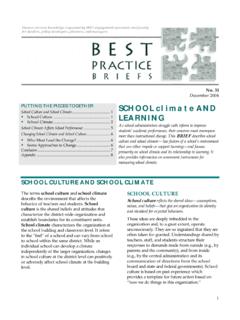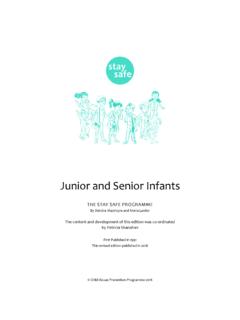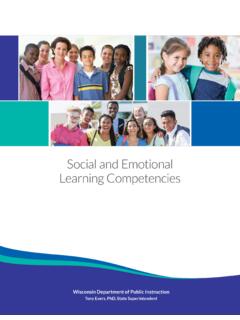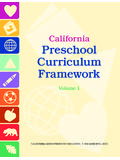Transcription of Psychological Safety and Learning Behavior in Work Teams
1 Psychological Safety and Learning Behavior in Work TeamsAuthor(s): Amy EdmondsonSource: Administrative Science Quarterly, Vol. 44, No. 2 (Jun., 1999), pp. 350-383 Published by: Johnson Graduate School of Management, Cornell UniversityStable URL: : 01/04/2009 23:19 Your use of the JSTOR archive indicates your acceptance of JSTOR's Terms and Conditions of Use, available JSTOR's Terms and Conditions of Use provides, in part, that unlessyou have obtained prior permission, you may not download an entire issue of a journal or multiple copies of articles, and youmay use content in the JSTOR archive only for your personal, non-commercial contact the publisher regarding any further use of this work.
2 Publisher contact information may be obtained copy of any part of a JSTOR transmission must contain the same copyright notice that appears on the screen or printedpage of such is a not-for-profit organization founded in 1995 to build trusted digital archives for scholarship. We work with thescholarly community to preserve their work and the materials they rely upon, and to build a common research platform thatpromotes the discovery and use of these resources. For more information about JSTOR, please contact Graduate School of Management, Cornell University is collaborating with JSTOR to digitize, preserveand extend access to Administrative Science Safety and Learning Behavior in Work Teams Amy Edmondson Harvard University ?
3 1999 by Cornell University. 0001 -8392/99/4402-0350/$1 .00. I thank Richard Hackman for extensive advice and feedback on the design of this study and on several versions of this pa- per. Keith Murnighan, Rod Kramer, Mark Cannon, and three anonymous reviewers provided feedback that greatly benefited the final version of the paper. I gratefully acknowledge the Division of Research at the Harvard Business School for provid- ing financial support for this research. This paper presents a model of team Learning and tests it in a multimethod field study.
4 It introduces the construct of team Psychological Safety -a shared belief held by members of a team that the team is safe for interper- sonal risk taking-and models the effects of team psy- chological Safety and team efficacy together on Learning and performance in organizational work Teams . Results of a study of 51 work Teams in a manufacturing com- pany, measuring antecedent, process, and outcome vari- ables, show that team Psychological Safety is associated with Learning Behavior , but team efficacy is not, when controlling for team Psychological Safety .
5 As predicted, Learning Behavior mediates between team Psychological Safety and team performance. The results support an in- tegrative perspective in which both team structures, such as context support and team leader coaching, and shared beliefs shape team outcomes.' A growing reliance on Teams in changing and uncertain orga- nizational environments creates a managerial imperative to understand the factors that enable team Learning . Although much has been written about Teams and about Learning in organizations, our understanding of Learning in Teams re- mains limited.
6 A review of the team effectiveness and orga- nizational Learning literatures reveals markedly different ap- proaches and a lack of cross-fertilization between them. An emerging literature on group Learning , with theoretical papers on groups as information-processing systems and a number of empirical studies examining information exchange in labo- ratory groups, has not investigated the Learning processes of real work Teams (cf. Argote, Gruenfeld, and Naquin, 1999). Although most studies of organizational Learning have been field-based, empirical research on group Learning has primar- ily taken place in the laboratory, and little research has been done to understand the factors that influence Learning behav- ior in ongoing Teams in real organizations.
7 Studies of work Teams in a variety of organizational settings have shown that team effectiveness is enabled by structural features such as a well-designed team task, appropriate team composition, and a context that ensures the availability of information, resources, and rewards (Hackman, 1987). Many researchers have concluded that structure and design, including equipment, materials, physical environment, and pay systems, are the most important variables for improving work-team performance (Goodman, Devadas, and Hughson, 1988; Campion, Medsker, and Higgs, 1993; Cohen and Led- ford, 1994) and have argued against focusing on interper- sonal factors ( , Goodman, RavIin, and Schminke, 1987).
8 According to this research, organization and team structures explain most of the variance in team effectiveness. In contrast, organizational Learning research has emphasized cognitive and interpersonal factors to explain effectiveness, showing, for example, that individuals' tacit beliefs about in- terpersonal interaction inhibit Learning Behavior and give rise to ineffectiveness in organizations ( , Argyris, 1993). This cognitive emphasis takes different forms. Organizational Learning theorists have offered both descriptive theory ex- 350/Administrative Science Quarterly, 44 (1999): 350-383 Psychological Safety plaining the failure of organizations to adapt rationally due to cognitive biases that favor existing routines over alternatives ( , Levitt and March, 1988) and prescriptive theory propos- ing interventions that alter individuals' "theories-in-use" to improve organization effectiveness ( , Argyris and Schdn, 1 978).
9 The former theorists suggest that adaptive Learning in social systems is fundamentally problematic and rare, and the latter, only slightly more sanguine, propose that expert intervention is necessary to bring it about (cf. Edmondson and Moingeon, 1998). This paper takes a different approach to understanding Learning in organizations by examining to what extent and under what conditions Learning occurs natu- rally in organizational work groups. Much organizational Learning research has relied on qualita- tive studies that provide rich detail about cognitive and inter- personal processes but do not allow explicit hypothesis test- ing ( , Senge, 1990; Argyris, 1993; Watkins and Marsick, 1993).
10 Many team studies, in contrast, have used large samples and quantitative data but have not examined ante- cedents and consequences of Learning Behavior ( , Good- man, Devadas, and Hughson, 1988; Hackman, 1990; Cohen and Ledford, 1994). I propose that to understand Learning Behavior in Teams , team structures and shared beliefs must be investigated jointly, using both quantitative and qualitative methods. This paper presents a model of team Learning and tests it in a multimethod field study. The results support an integrative perspective in which both team structures, such as context support and team leader coaching, and shared beliefs shape team outcomes.

















